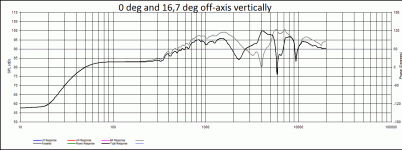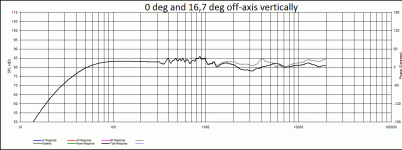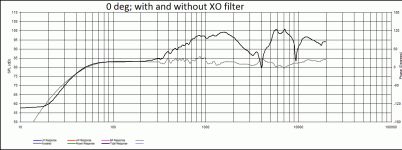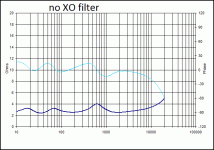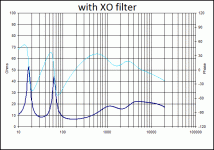I have read numerous times how crossover design will affect the sound, but haven't managed to find any clear explanations. What would be incredibly helpful to me and probably others is some guidance in what the results would sound like. I'll suggest a two way with the SB17NRX (8ohm) and SB29RDC 9(4ohm) as the standard. Crossover point about 1700Hz. How will different circuits affect the sound?
Please....
Drew
Please....
Drew
It affects the sound as following.
A well designed crossover will sound good and measure quite well.
A poorly designed one will sound bad and will measure quite poorly.
The subject is very complex and there is no way to come up with an easy answer. Some designers measures carefully but doesn't listen to the speaker during development so very much. For others it's the other way around.
The best thing for a hobbyist is to build a kit.
A well designed crossover will sound good and measure quite well.
A poorly designed one will sound bad and will measure quite poorly.
The subject is very complex and there is no way to come up with an easy answer. Some designers measures carefully but doesn't listen to the speaker during development so very much. For others it's the other way around.
The best thing for a hobbyist is to build a kit.
The first thing you need to understand is that crossovers do not just cut off the frquency for each driver at a particular frequency (what is known as a brick wall filter) They cause a gentle rolloff of each drivers response.
The final result is the summing of BOTH the drivers in the crossover region. So depending on how this is implemented each driver should ideally be contributing equally to the final sound. Actually achieving this is difficult, due to differences in the drivers. The crossover itself (electrically speaking) is one thing, it is how it interacts with the driver to give an acoustic result (and how well that matches the acoustic result of the other driver) that matters.
Tony.
The final result is the summing of BOTH the drivers in the crossover region. So depending on how this is implemented each driver should ideally be contributing equally to the final sound. Actually achieving this is difficult, due to differences in the drivers. The crossover itself (electrically speaking) is one thing, it is how it interacts with the driver to give an acoustic result (and how well that matches the acoustic result of the other driver) that matters.
Tony.
It's pretty much all in the crossover. It's what makes a particular speaker sound the way it sounds- within reason of course. Ribbons will sound different from domes and horns will sound different from direct radiators, but within a given selection of drivers the order of importance is:
1. crossover frequency,
2. crossover slope
3. optimization of crossover values to match the chosen target curves (i.e. how close you get to the design goal in 1 and 2 )
4. quality of components.
1. crossover frequency,
2. crossover slope
3. optimization of crossover values to match the chosen target curves (i.e. how close you get to the design goal in 1 and 2 )
4. quality of components.
hi Drewan,
I have a couple of links for you. First, discusses very basically how crossovers work:
https://speakermakersjourney.blogspot.com/2016/02/crossover-basics.html
The second is the LM-1 2-way. The important part for you is that crossover simulation files are available near the end. This will help you evaluate how different choices affect the speaker response.
https://speakermakersjourney.blogspot.com/2016/02/the-lm-1-bookshelf-version.html
Best,
E
I have a couple of links for you. First, discusses very basically how crossovers work:
https://speakermakersjourney.blogspot.com/2016/02/crossover-basics.html
The second is the LM-1 2-way. The important part for you is that crossover simulation files are available near the end. This will help you evaluate how different choices affect the speaker response.
https://speakermakersjourney.blogspot.com/2016/02/the-lm-1-bookshelf-version.html
Best,
E
I have read numerous times how crossover design will affect the sound, but haven't managed to find any clear explanations. What would be incredibly helpful to me and probably others is some guidance in what the results would sound like. I'll suggest a two way with the SB17NRX (8ohm) and SB29RDC 9(4ohm) as the standard. Crossover point about 1700Hz. How will different circuits affect the sound?
Please....
Drew
Crossover design is everything when it comes to sound quality. The best drivers with a poor crossover will sound crappy. Mediocre drivers with an exceptional crossover will sound very good. Voicing is the next step and is equally important.
An accomplished crossover designer will require the cabinet with drivers installed and then measure repeatedly, configure and the listen, measure, configure, listen. This process goes on until the design sounds as good as possible before they sign off on it. Each crossover designer has their own signature voicing which I find to be one of the most important parts of the development project. Curt Campbell and I have partnered on all of the Statements series speakers, Finalists and Anthology's for the last 10 years. Curt slaves away to get the design just right. His voicing sounds natural to my ears.
I'm a Luddite and don't do electronic crossovers except for subs for all the reasons I just listed.
Pick a well designed kit from a respected designer and you'll be happy. Of course I highly recommend anything Curt has touched.
My $.02 worth.
Jim
This sticky is a good place to start to understand crossovers from an intuitive point of view:
< http://www.diyaudio.com/forums/mult...designing-crossovers-without-measurement.html >
< http://www.diyaudio.com/forums/mult...designing-crossovers-without-measurement.html >
I have read numerous times how crossover design will affect the sound, but haven't managed to find any clear explanations. Drew
I suppose a picture would have made more sense in explaining the sound differences than words could. I did sim the response with the units of your choosing, only the XO frequency was 2 kHz.
Attachments
You'll get good answers, with real depth of knowledge from other posters.
Here's my take: well designed drivers are predictable and need little consideration within their best operating range.
I like larger paper cone midrange drivers that crossover to a tweeter (or horn) before the 'squiggly' part of their Frequency response test curve starts.
Same with tweeters - they should crossover above their lowest specified point to avoid erratic behavior.
I like fewer parts.
That often means more expensive but not 'exotic' drivers in big enclosures.
I strongly recommend the SEOS based kits (for affordable horn designs) or
Troels Gravesen's deep DIY pages.
Either way, kits will save you money in the long run.
http://www.diysoundgroup.com
http://www.troelsgravesen.dk
Sent from my Nexus 6 using Tapatalk
Here's my take: well designed drivers are predictable and need little consideration within their best operating range.
I like larger paper cone midrange drivers that crossover to a tweeter (or horn) before the 'squiggly' part of their Frequency response test curve starts.
Same with tweeters - they should crossover above their lowest specified point to avoid erratic behavior.
I like fewer parts.
That often means more expensive but not 'exotic' drivers in big enclosures.
I strongly recommend the SEOS based kits (for affordable horn designs) or
Troels Gravesen's deep DIY pages.
Either way, kits will save you money in the long run.
http://www.diysoundgroup.com
http://www.troelsgravesen.dk
Sent from my Nexus 6 using Tapatalk
So....if the end measurements are the same, Frequency Response, impulse, step, distortion etc. then the speakers will sound the same despite the possibility of different circuit designs getting there. (Assuming that the components are all of the same quality of course.)??
Thanks
Drew
Thanks
Drew
drewan,
It's not clear that we measure everything we perceive, or that if this is the case we have agreed to all of it.
Just as an aside, you are missing radiation pattern: compression (i.e. linearity), IM distortion, thermal compression, group delay, etc., etc., etc.
The interaction with the room has a lot to do with a speaker's sound, and that is not predictable by simple measurements across 2 chart axis (dB vs. f for instance).
I will say that despite what a lot of audiophiles state, not all measurements are the same, and frequency response is the first and most obvious to everyone, so that's a good place to start.
I would work backwards from the ear. If the instantaneous pressure at the ear is the same, then the sound will be the same. Now you have to work backwards through the body, the room, the drivers, the crossover and cabinet to the amplifier outputs. Our minds are limited to only handling a few dimensions at a time, so we simplify speaker design into very limited models that cannot experience everything we experience. I say this as some one who loves OmniMic and XSim. As great as they are, there's always more data to take into account and at some point we must stop and actually build something.
Best,
E
It's not clear that we measure everything we perceive, or that if this is the case we have agreed to all of it.
Just as an aside, you are missing radiation pattern: compression (i.e. linearity), IM distortion, thermal compression, group delay, etc., etc., etc.
The interaction with the room has a lot to do with a speaker's sound, and that is not predictable by simple measurements across 2 chart axis (dB vs. f for instance).
I will say that despite what a lot of audiophiles state, not all measurements are the same, and frequency response is the first and most obvious to everyone, so that's a good place to start.
I would work backwards from the ear. If the instantaneous pressure at the ear is the same, then the sound will be the same. Now you have to work backwards through the body, the room, the drivers, the crossover and cabinet to the amplifier outputs. Our minds are limited to only handling a few dimensions at a time, so we simplify speaker design into very limited models that cannot experience everything we experience. I say this as some one who loves OmniMic and XSim. As great as they are, there's always more data to take into account and at some point we must stop and actually build something.
Best,
E
Last edited:
So....if the end measurements are the same, Frequency Response, impulse, step, distortion etc. then the speakers will sound the same despite the possibility of different circuit designs getting there. (Assuming that the components are all of the same quality of course.)??
Nope. You forget what comes after the electrical part, the trasduction.
The design of the driver( speaker) itself lends to a balance of parts.
Those are indeed represented with electrical symbols, like inductance, resistivity, capacity.
What we are interested more is the resistivity, in acoustics, as it represents air impedance but also the frictions inside the loudspeaker ; the energy storage ( inductance ? ) is to be avoided as it produces resonance . ETC is another important kind of measure
FWIW
So....if the end measurements are the same, Frequency Response, impulse, step, distortion etc. then the speakers will sound the same despite the possibility of different circuit designs getting there. (Assuming that the components are all of the same quality of course.)??
Thanks
Drew
1st of all, I'm not a crossover designer, just an audiophile that has worked with a number of really excellent crossover designers over the last couple decades on projects I've designed. Crossover slopes range from 1st order to 8th order and all can end up with the same frequency response, within reason but most will sound somewhat different due to overlap, driver requirements etc. Many times the slopes between drivers will be different order based on what allows the driver to sound best. Experience, measuring and listening are key.
Don't minimize voicing. It's the difference between a speaker that sounds natural to one that sounds sterile or "hi-Fi".
That's what I've picked up over the years from the guys that are really, really good at crossover design. Flat is where you start but rarely where you end if the best sound quality possible is the end goal.
Jim
Thanks, I specced the drivers and crossover point for this, I thought I'd stated the box to be sealed and 16l, but somehow copy and paste got screwed. I do really appreciate the discussion. So the measurements could be the same but the speakers still sound different.
Which measurements should we be examining if we are looking for an "airy" sound, or speakers that put the vocalist standing 6 ft in front of you? beetter still, both? Are these qualities measurable even measuring pairs of speakers at the listening position?
Thanks
Drew
Which measurements should we be examining if we are looking for an "airy" sound, or speakers that put the vocalist standing 6 ft in front of you? beetter still, both? Are these qualities measurable even measuring pairs of speakers at the listening position?
Thanks
Drew
There are measurements and there are measurements. Yes. Speaker design is better when three dimensions are considered.the measurements could be the same but the speakers still sound different.
More highs, more upper mids maybe? This is subjective, it may not sound natural.Which measurements should we be examining if we are looking for an "airy" sound, or speakers that put the vocalist standing 6 ft in front of you?
To some degree, yes, ie the room brings together other sound and measurement of specific things gets harder.Are these qualities measurable even measuring pairs of speakers at the listening position?
Jholtz, you say we shouldn't minimize voicing.
I agree, but if so you must have some good judgement. And be experienced so you don't will be carried away by your new baby. All new stuff sounds good, we humans are built that way and sometimes it takes some time to figure out what really is good.
Then of course people are different. If you happen to be a typical rational type, then you might confuse a "clear" sound with quality. If so perhaps it's best to stick to the measurements.
It seems that the most hard thing to get right is to make a speaker or amplifier "digestible" so to speak. The newbee always tend to construct things that sounds sharp, clear and analytical, but with experience comes the mellowness. This seems to be some law of nature.
The danish amplifier brand "Thule" was crystal clear in it's appearance when it first saw the light of the day some twenty years ago. But was impossible to enjoy. When I listened to a new model perhaps ten years later the sound was really pleasant. This is a typical evolution of an audio engineer.
Even Nelson Pass seemed to suffer from that. He said in some document I read that his first constructions had "everything but a kitchen sink" in their busty innards. Until he discovered that simplicity seemed to please our ears better.
I agree, but if so you must have some good judgement. And be experienced so you don't will be carried away by your new baby. All new stuff sounds good, we humans are built that way and sometimes it takes some time to figure out what really is good.
Then of course people are different. If you happen to be a typical rational type, then you might confuse a "clear" sound with quality. If so perhaps it's best to stick to the measurements.
It seems that the most hard thing to get right is to make a speaker or amplifier "digestible" so to speak. The newbee always tend to construct things that sounds sharp, clear and analytical, but with experience comes the mellowness. This seems to be some law of nature.
The danish amplifier brand "Thule" was crystal clear in it's appearance when it first saw the light of the day some twenty years ago. But was impossible to enjoy. When I listened to a new model perhaps ten years later the sound was really pleasant. This is a typical evolution of an audio engineer.
Even Nelson Pass seemed to suffer from that. He said in some document I read that his first constructions had "everything but a kitchen sink" in their busty innards. Until he discovered that simplicity seemed to please our ears better.
I haven't done a 2-way for 15 years so I can't advise on voicing. Airy = a slightly rising frequency response above 10K which is usually accomplished with a small change in a series resistor in the tweeter crossover. I have no idea on a 2-way for the kind of voicing you want. 6 feet in front of the speakers would be extremely forward and I've never heard a speaker with that type of voicing.Thanks, I specced the drivers and crossover point for this, I thought I'd stated the box to be sealed and 16l, but somehow copy and paste got screwed. I do really appreciate the discussion. So the measurements could be the same but the speakers still sound different.
Which measurements should we be examining if we are looking for an "airy" sound, or speakers that put the vocalist standing 6 ft in front of you? beetter still, both? Are these qualities measurable even measuring pairs of speakers at the listening position?
Thanks
Drew
Jim
Jholtz, you say we shouldn't minimize voicing.
I agree, but if so you must have some good judgement. And be experienced so you don't will be carried away by your new baby. All new stuff sounds good, we humans are built that way and sometimes it takes some time to figure out what really is good.
Then of course people are different. If you happen to be a typical rational type, then you might confuse a "clear" sound with quality. If so perhaps it's best to stick to the measurements.
It seems that the most hard thing to get right is to make a speaker or amplifier "digestible" so to speak. The newbee always tend to construct things that sounds sharp, clear and analytical, but with experience comes the mellowness. This seems to be some law of nature.
The danish amplifier brand "Thule" was crystal clear in it's appearance when it first saw the light of the day some twenty years ago. But was impossible to enjoy. When I listened to a new model perhaps ten years later the sound was really pleasant. This is a typical evolution of an audio engineer.
Even Nelson Pass seemed to suffer from that. He said in some document I read that his first constructions had "everything but a kitchen sink" in their busty innards. Until he discovered that simplicity seemed to please our ears better.
Yep, everyone thinks their speakers sound awesome. The difference is a crossover designer that has been designing crossovers for 20-30 years knows he difference. They voice to natural rather than to the 'wow that sounds great" stage.
Jim
- Status
- This old topic is closed. If you want to reopen this topic, contact a moderator using the "Report Post" button.
- Home
- Loudspeakers
- Multi-Way
- how does crossover design affect sound?
